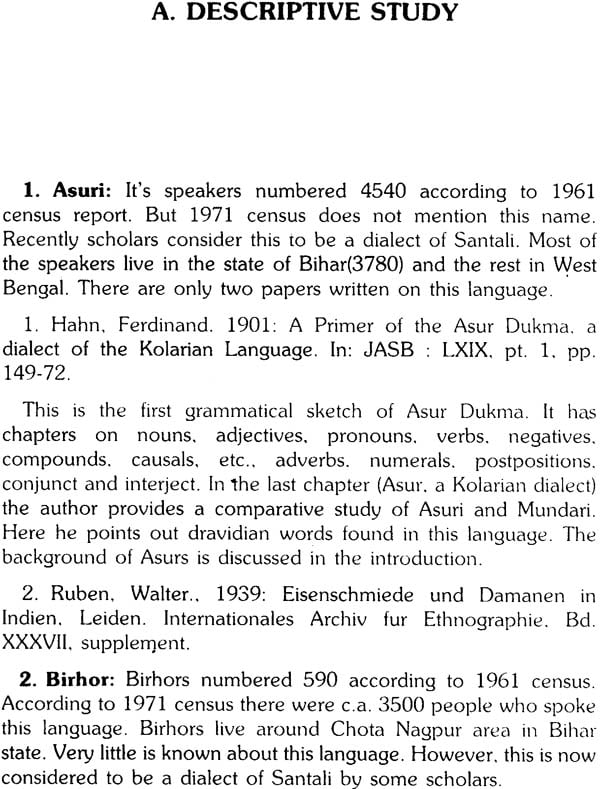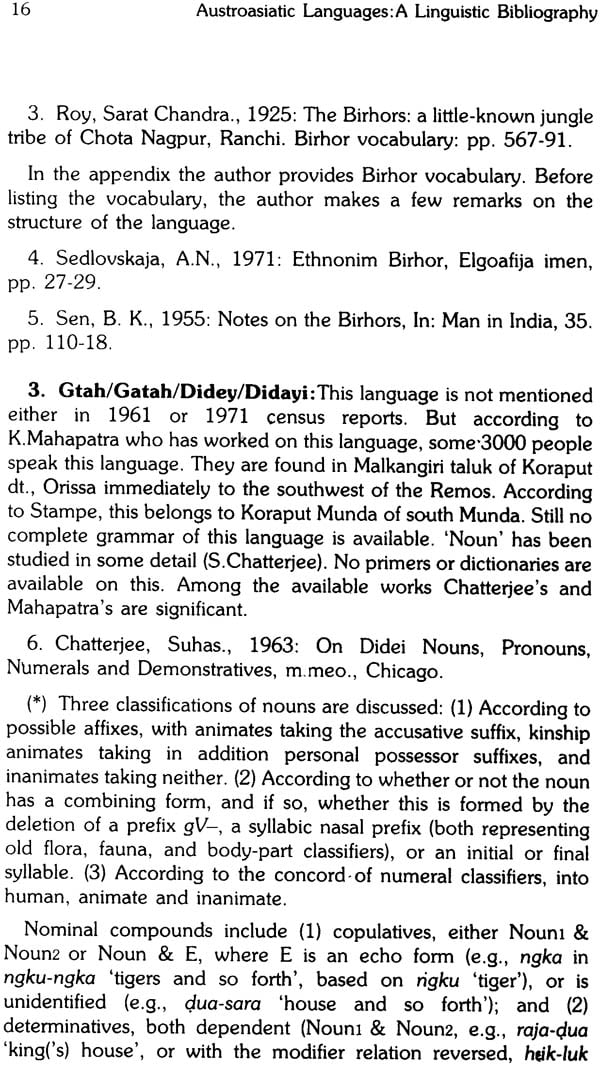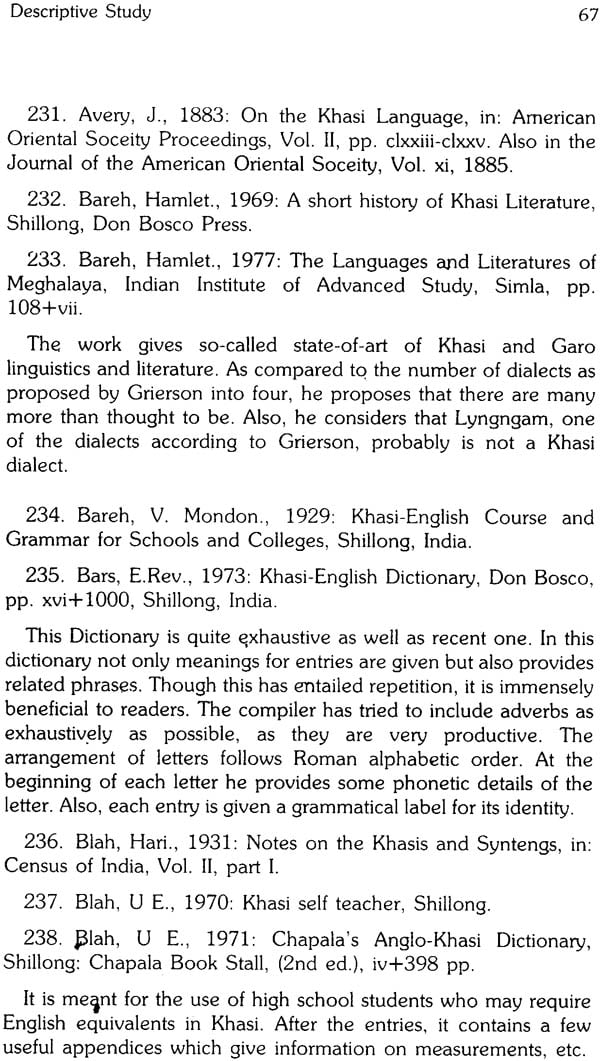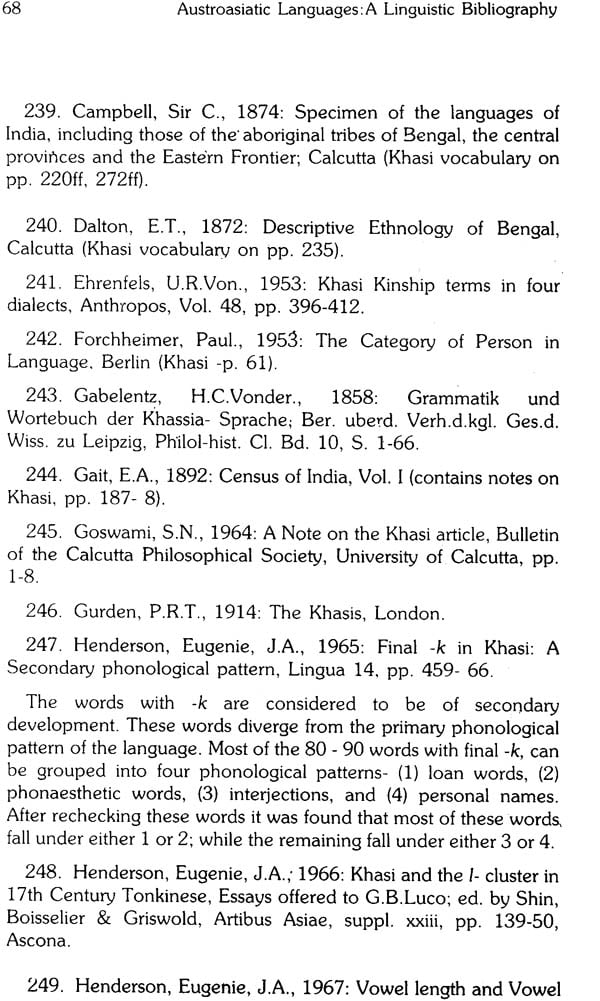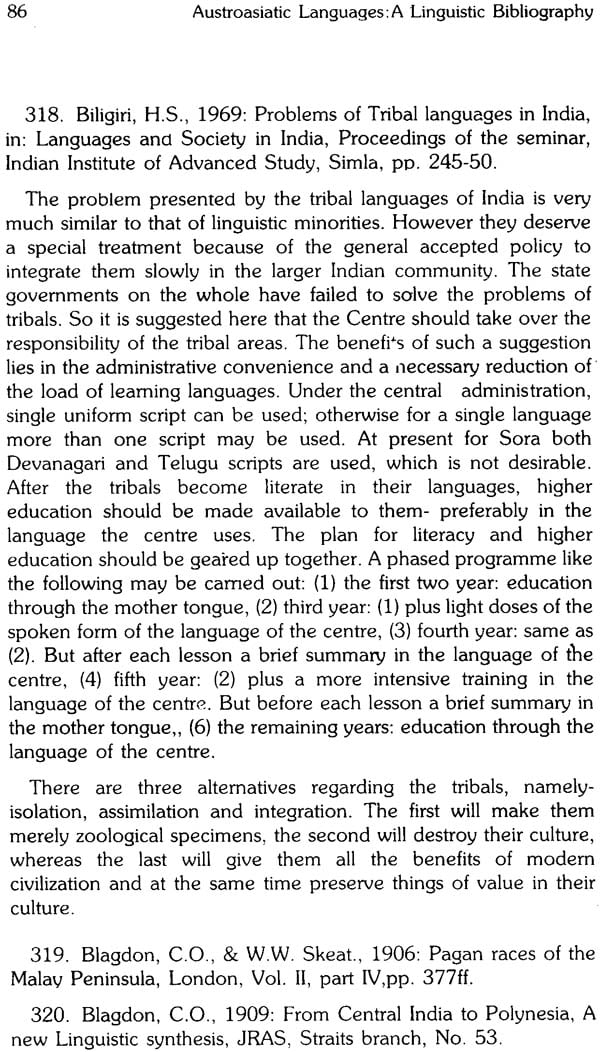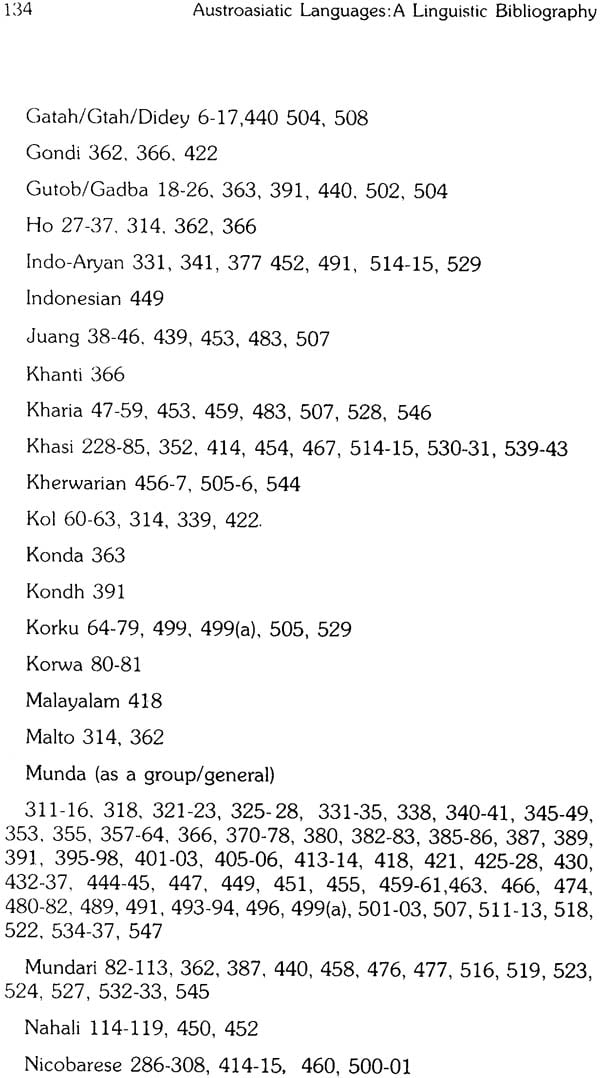
Austroasiatic Languages a Linguistic Bibliography (An Old and Rare Book)
Book Specification
| Item Code: | NAM202 |
| Author: | K. S. Nagaraja |
| Publisher: | Deccan College Postgraduate and Research Institute |
| Language: | English |
| Edition: | 1989 |
| Pages: | 158 |
| Cover: | Paperback |
| Other Details | 9.0 inch X 6.0 inch |
| Weight | 240 gm |
Book Description
I am very happy to present this bibliography on the occasion of the Golden Jubilee of the Instituted. It is restricted to the Austro- asiatic languages spoken in India, namely, Munda and Nicobarese braches and Khasi of Moh-Khmer branch.
For the last four decades no detailed bibliography on these languages was available. In a developing field like Austro-asiatic Linguistics, more than twenty years (since Stamp’s restricted work in 1965) is quite long period and another compilation was undoubtedly long overdue. This bibliography, which was a desideratum, will no doubt. This bibliography, which was a desideratum will no doubt be welcome by researchers in the field. If not only lists recent research work on these languages, but also incorporates Pinnow’s and Stampe’s compilations. Future, it provides annotations to over 200 entries. It is thus both exhaustive and upto date.
This Bibliography is restricted to the Austroasiatic languages spoken in India only. That means it covers Munda languages spoken in Central and north-eastern parts of the India and spreading upto the banks of Godavari river in the south. Khasi language of Mon-Khmer branch spoken in Khasi and Jaintia hill districts of Meghalaya state and Nicobarese, spoken in Nicobar Islands.
Munda group of Speaker total around six million (Census 1971), in which Santail takes the major share with 3.7 million speakers: Khasi speakers total 3,63,300 (including various dialects); and Nicobarese speakers number 17000.
The present bibliography is a revised and enlarged version of the one prepared in 1980 for Munda languages only. In this work materials on Khasi and Nicobarese are incorporated.
As early as in 1906 for the first time Wilhelm Schmidt, the real discoverer of the Austroasictic family, propounded the theory that the Munda languages, khasi and Nicobar , Palaung-Wa, Mon-Khmer, Malacca and Cham languages belonged to a family called ‘Austric’ (‘austroasiatisher sprachchstamm’) (Pinnow 1963). Though at that time it raised serious doubts about the validity of this theory, later scholars found that the theory was very much accurate except for two points: one was that he considered Cham languages as Austric. Which were later classified as belonging Austronesian (Malayo-Polynesian). Second, he considered Vietnamese to be non-Austroasiatic. Schmidt’s articles for the first time supported the Austroasiatic hypothesis with lexical, phonological and morphological evidence. They remain until today the basic works of Austroasiatic studies (G.Diffloth:1980).
Schmidt grouped the Munda languages into three subgroups on the basis of the distribution of k and h (from proto-Munda*q) into the following:
1. an eastern group (Kherwari, with h);
2. a western group (Kurku, kharia, Juang with k); and
3. a mixed group (south-eastern Mundari with a loss of Proto Munda*q).
As this classification was based on a single argument it could not do justice to the facts.
Later, H.J. Pinnow (in 1959 through his extensive studies on Munda languages) showed that the verbal inflection of all Munda languages is traceable to a Proto Munda inflectional system which was later expanded in the north and considerably reduced in the south. From this evidence and on the basis of lexical differences the Munda languages were classified into a northern group with the subgroups Kurku and Kherwari (Santali, Mundari, Korwa, etc., belong to the latter group), and a southern group which is further subdivided into a central group (including Kharia and Juang), and a south-eastern group (including Sora, Pareng Gutob and Remo). The relation of Kherwari and Kurku is much closer than that of central and south-eastern Munda, which must have been separated much earlier than kherwari and kurku.
This classification of Pinnow was adopted with slight modification by the later scholars like Norman Zide and David Stampe. It recognized the following languages- Gatah, Gutob, Ho, Juang, Kharia, Korku, korwa, Mundari, Remo, Santali and Sora. The Complete stammbaum is as follows:
In 1975 S. Battacharya provided a fresh classification based mainly on his own field work on different Munda languages and also based on other available sources. He identified ten independent Munda languages and six important dialects. These languages are grouped into two branches and sub-grouped further. This classification is graphically represented in the following stammbaum:
Bhattacharya showed that there are many major differences between Upper Munda languages and Lower Munda languages. Firstly, the absence of the pronominal objects markers in verb stems in LM as versus its presence in UM. This is the main distinguishing feature. Secondly, the languages of LM have-n for genitive marker, while all the UM languages have –a/-a’. Thirdly, in combination with kinship terms of the words for wards for parts of the body the pronominal elements of the first and second persons are usually Prefixed in LM; but suffixed in UM. Also, in the formation of non-singular numbers LM differs from UM.
Arelene Zide (item no22) considers that Juray to be a closely related sister language of Sora. It has approximately 6-7000 speakers and is spoken is ca. 25-30 village in Gunjam district of Orissa and neighbouring districts in both AP and Orissa Till 1972 it was considered a dialect of Sora.
Further, still there are problems of identification of certain language names and groupings. For instance, in the S.B’s classification above (i) Birhor and Asuri are considered a dialects of Santali; (ii) Ho is considered as the dialects of Korku. But according to Pinnow- Stampe, except for Birhor and Asuri; Ho, Koraku and Kor(a) wa, are separate languages. Also the terminologies are different so this creates confusion. Therefore standardization of terminologies is also very urgently required. In this work the terminologies is also very urgently required. In this work the terminologies provided by Pinnow-Stampe are used. However, alternative terminologies re provided are provided in the headings themselves where available.
As far as Nahali is considered-Pinnow considers it to possibly belong to western group of Austroasiatic along with Munda. Stampe-Zide consider it to belong to Austroasiatic if not to Munda branch itself. On the other hand, Bhattacharya considers it to belong to a separate group. On the whole the status of Nahali is yet to be resolved.
I this bibliography Nahali is included in the Munda group itself. It is done solely on its geographical considerate alone.
The purpose of this bibliography is to put together the available literature on Austroasiatic languages of Indian in one place, as such one is not available till now. Pinnow in 1959 listed for the first time all the available literature on these languages. Later in 1965-66 David Stampe gave an annotated bibliography for available works for the period between 1959 to 1965 in IJAL. He also made a mention of forth-coming papers, collections, etc. In. other words he provided a state-of-art report. No bibliography has since been compiled. In a developing field like Munda linguistics in particular and Austroasiatic linguistics in general, twenty years period is quite a long time and another compilation has undoubtedly been long due. This bibliography not only lists fresh research work on Munda, Khasi and Nicobarese languages, but also incorporates Pinnow's and Stampe's compilations. The present volume is thus both exhaustive and upto date.
In this listing, effort has been made to give annotations to entries wherever possible, to books and articles available in the nearby sources; irrespective of the date of publication of these books/ articles. In this process, instead of writing separate annotations for those to which Stampe had provided in IJAL, by that duplicating the work already done; I have taken these annotations as they were and have included them in this work. They are identified by using an 'asterisk' in the beginning of the entry. This has considerably reduced my efforts to write annotations to around 70 entries. But here it must be mentioned that as far as entries with 'forthcoming' tag in stampe's are concerned, I have omitted all those which have not come out in print till now- at least they have not reached the Indian soil; or no references to them was available in any of the other writings. So I omitted these and restricted myself to the ones which have appeared in journals or in the form of books. Annotations were given to those works which were available to me and were in English; so that out of the 500 and odd entries in this bibliography annotations are given only to around 200 entries.
The Bibliography consists of the 'main body' which consists of more than 500 entries; preceded by (i) an introduction, (ii) a list of sources and (iii) a list of periodicals and journals; and followed by author and language indices.
The 'main body' consists of three sections - the first A is the 'language' section wherein all descriptive work on each language is listed under each language head, arranged alphabetically. Here the Munda languages are arranged alphabetically; followed by Khasi and Nicobarese. In section B 'general' articles and books which deal with Austroasiatic languages in a 'general' manner - in the sense that they refer to these languages only as part of broader topic, are listed alphabetically. In section C 'comparative studies' within and across Austroasiatic family are listed alphabetically.
| Introduction | 1 | |
| Sources | 9 | |
| List of Periodicals | 11 | |
| Part A: | Descriptive Study | 15 |
| 1 | Asuri | 15 |
| 2 | Birhor | 15 |
| 3 | Gatah/Gtah/Didey | 16 |
| 4 | Gutob/Gadaba | 18 |
| 5 | Ho | 21 |
| 6 | Juang | 23 |
| 7 | Kharia | 26 |
| 8 | Kol | 29 |
| 9 | Korku/Kurku | 29 |
| 10 | Korwa | 34 |
| 11 | Mundari | 34 |
| 12 | Nahali | 41 |
| 13 | ParengilGorum | 43 |
| 14 | Remo/Bonda | 49 |
| 15 | Santali | 51 |
| 16 | Sora/Saora | 58 |
| 17 | Turi | 65 |
| 18 | Khasi | 66 |
| 19 | Nicobarese | 79 |
| Part B: | General Study | 85 |
| Part C: | Comparative Study | 101 |
| Addenda | 128 | |
| Language Index | 133 | |
| Author Index | 137 |
